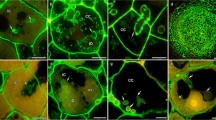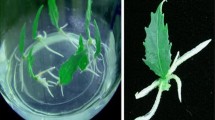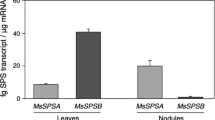Abstract.
The localization of H+-ATPases in soybean (Glycine max L. cv. Stevens) nodules was investigated using antibodies against both P-type and V-type enzymes. Immunoblots of peribacteroid membrane (PBM) proteins using antibodies against tobacco and Arabidopsis H+-ATPases detected a single immunoreactive band at approximately 100 kDa. These antibodies recognized a protein of similar relative molecular mass in the crude microsomal fraction from soybean nodules and uninoculated roots. The amount of this protein was greater in PBM from mature nodules than in younger nodules. Immunolocalization of P-type ATPases using silver enhancement of colloidal-gold labelling at the light-microscopy level showed signal distributed around the periphery of non-infected cells in both the nodule cortex and nodule parenchyma. In the central nitrogen-fixing zone of the nodule, staining was present in both the infected and uninfected cells. Examination of nodule sections using confocal microscopy and fluorescence staining showed an immunofluorescent signal clearly visible around the periphery of individual symbiosomes which appeared as vesicles distributed throughout the infected cells of the central zone. Electron-microscopic examination of immunogold-labelled sections shows that P-type ATPase antigens were present on the PBM of both newly formed, single-bacteroid symbiosomes just released from infection threads, and on the PBM of mature symbiosomes containing two to four bacteroids. Immunogold labelling using antibody against the B-subunit of V-type ATPase from oat failed to detect this protein on symbiosome membranes. Only a very faint signal with this antibody was detected on Western blots of purified PBM. During nodule development, fusion of small symbiosomes to form larger ones containing multiple bacteroids was observed. Fusion was preceded by the formation of cone-like extensions of the PBM, allowing the membrane to make contact with the adjoining membrane of another symbiosome. We conclude that the major H+-ATPase on the PBM of soybean is a P-type enzyme with homology to other such enzymes in plants. In vivo, this enzyme is likely to play a critical role in the regulation of nutrient exchange between legume and bacteroids.
Similar content being viewed by others
Author information
Authors and Affiliations
Additional information
Received: 25 November 1998 / Accepted: 6 January 1999
Rights and permissions
About this article
Cite this article
Fedorova, E., Thomson, R., Whitehead, L. et al. Localization of H+-ATPases in soybean root nodules. Planta 209, 25–32 (1999). https://doi.org/10.1007/s004250050603
Issue Date:
DOI: https://doi.org/10.1007/s004250050603




